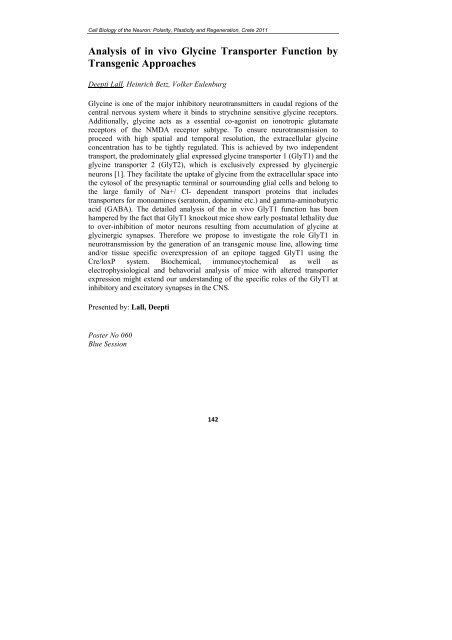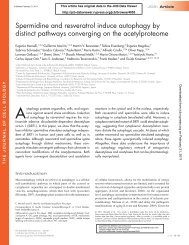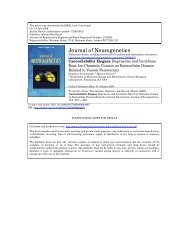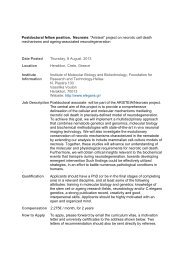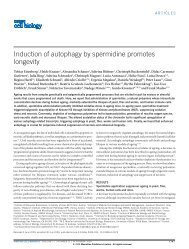CELL BIOLOGY OF THE NEURON Polarity ... - Tavernarakis Lab
CELL BIOLOGY OF THE NEURON Polarity ... - Tavernarakis Lab
CELL BIOLOGY OF THE NEURON Polarity ... - Tavernarakis Lab
You also want an ePaper? Increase the reach of your titles
YUMPU automatically turns print PDFs into web optimized ePapers that Google loves.
Cell Biology of the Neuron: <strong>Polarity</strong>, Plasticity and Regeneration, Crete 2011<br />
Analysis of in vivo Glycine Transporter Function by<br />
Transgenic Approaches<br />
Deepti Lall, Heinrich Betz, Volker Eulenburg<br />
Glycine is one of the major inhibitory neurotransmitters in caudal regions of the<br />
central nervous system where it binds to strychnine sensitive glycine receptors.<br />
Additionally, glycine acts as a essential co-agonist on ionotropic glutamate<br />
receptors of the NMDA receptor subtype. To ensure neurotransmission to<br />
proceed with high spatial and temporal resolution, the extracellular glycine<br />
concentration has to be tightly regulated. This is achieved by two independent<br />
transport, the predominately glial expressed glycine transporter 1 (GlyT1) and the<br />
glycine transporter 2 (GlyT2), which is exclusively expressed by glycinergic<br />
neurons [1]. They facilitate the uptake of glycine from the extracellular space into<br />
the cytosol of the presynaptic terminal or sourrounding glial cells and belong to<br />
the large family of Na+/ Cl- dependent transport proteins that includes<br />
transporters for monoamines (seratonin, dopamine etc.) and gamma-aminobutyric<br />
acid (GABA). The detailed analysis of the in vivo GlyT1 function has been<br />
hampered by the fact that GlyT1 knockout mice show early postnatal lethality due<br />
to over-inhibition of motor neurons resulting from accumulation of glycine at<br />
glycinergic synapses. Therefore we propose to investigate the role GlyT1 in<br />
neurotransmission by the generation of an transgenic mouse line, allowing time<br />
and/or tissue specific overexpression of an epitope tagged GlyT1 using the<br />
Cre/loxP system. Biochemical, immunocytochemical as well as<br />
electrophysiological and behavorial analysis of mice with altered transporter<br />
expression might extend our understanding of the specific roles of the GlyT1 at<br />
inhibitory and excitatory synapses in the CNS.<br />
Presented by: Lall, Deepti<br />
Poster No 060<br />
Blue Session<br />
142


